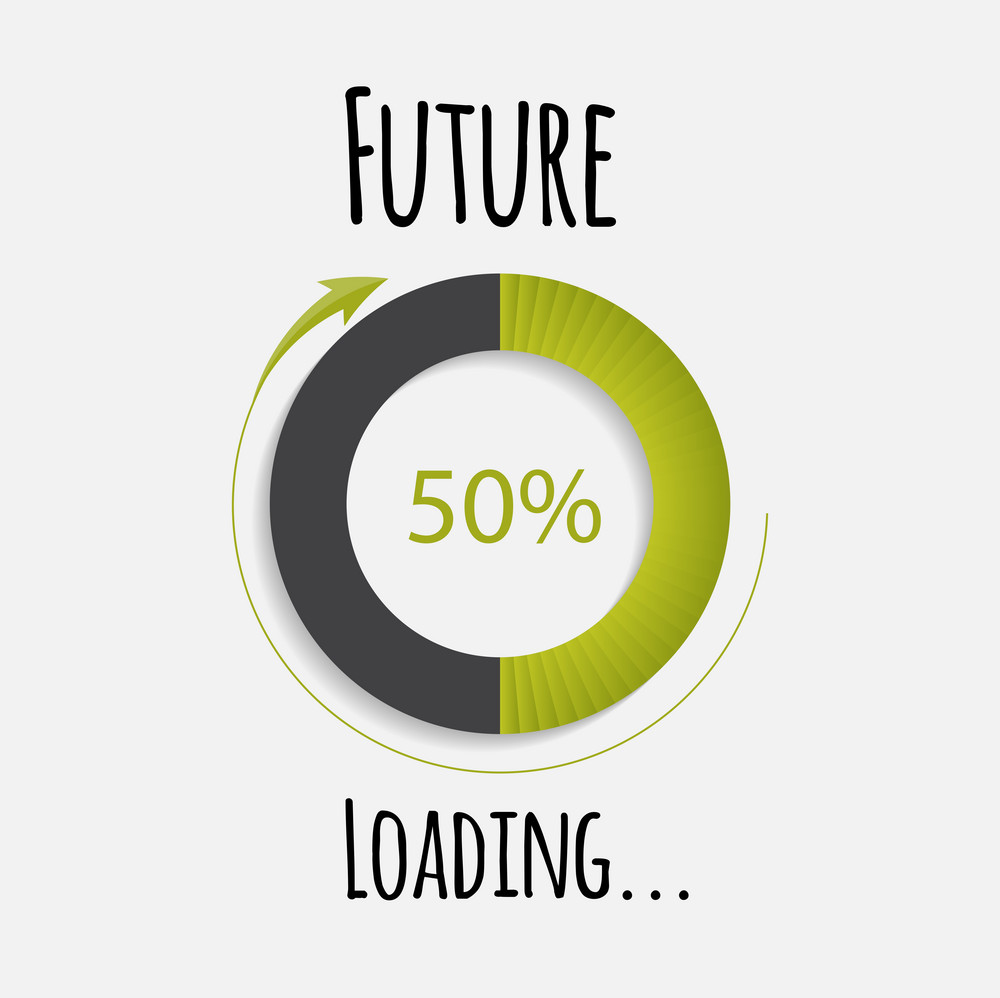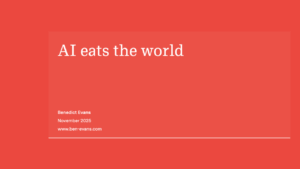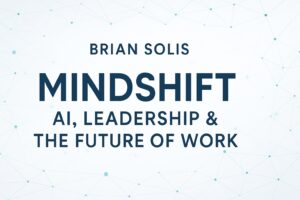
Each year, the Altimeter analyst team predicts digital trends that will have the biggest impact on businesses. In 2019, my colleagues Charlene Li, Omar Ahktar, Susan Etlinger, along with yours truly, share our take on what we see as most important trends to follow.
Digital Transformation, Digital Experience, Brand and Innovation: Brian Solis
CIOs Become Cross-Functional Business Partners to Accelerate Enterprise-Wide Digital Transformation
The “digital” in digital transformation is no longer just about investing in the latest disruptive technology trends. IT is also becoming an important strategic partner in facilitating the business goals of key stakeholder groups across the company. As such, the IT organization is dividing efforts to lead enterprise-wide digital transformation while also enabling business groups to modernize and grow according to their respective roadmaps. This creates a hybrid, agile operational approach that aligns technology and resource investments with the needs and objectives of each group to attain transformation and business goals.
CMOs Move Beyond Marketing to Drive Business Growth
While CIOs are driving modern technology integration and digital transformation, CMOs are expanding their role beyond traditional marketing and top-of-the-funnel activities. The CMO purview will expand to include customer experiences across all touchpoints. CMOs will align modern technologies with advanced capabilities to drive business performance and growth. With incredible strides in AI, machine learning and real-time analytics, CMOs can convert customer insights with advanced operational resources to deliver personalized value in real-time throughout the customer journey and lifecycle. Doing so will earn marketing a much more valued and important role in the C-Suite.
Technology Leaders are Held Responsible for Misleading and Underwhelming Responses to Company Scandals
Over the years, social media platforms and devices have played incredibly influential roles in shaping user relationships with technology and also their perspectives, behaviors and actions. We are now also starting to realize the extent to which technology companies employed persuasive designs to trigger desired user behaviors and engagement. In light of global events, we are also continuing to learn about massive (and ongoing) data and privacy breaches, widespread manifestation of fake accounts, news and manipulated algorithms and the adverse effects on relationships, politics and markets.
The all-too-common “we can do better” response of tech executives seems to have become the equivalent of “thoughts and prayers” according to leading communication strategist Shel Holtz. In 2019, users and market influencers (and maybe regulators) will hold Silicon Valley to task. This will either lead to shifts in leadership and/or very public campaigns aimed at building security, creating positive and productive user experiences and rebuilding trust. There are many precedents here, most recently with the ouster of Uber CEO Travis Kalanick and the appointment of Dara Khosrowshahi in 2017.
Digital Marketing Innovation & Digital Customer Experience: Omar Akhtar
IoT Becomes a Digital Marketing Channel
So far, connected/smart devices have been great at transmitting customer data back to the brand, but in 2019, we’re going to see a lot more two-way messaging occurring on devices. There’s no reason marketing should stop once the customer has bought the product. Brands can continue to message customers through connected devices, or mobile apps that are synced with those connected devices. Think of the messages you get on your Fitbit app informing you of new features, upgrades or related devices. They’re all based on real actions you’re taking using the connected device. Marketers have an opportunity to send relevant messages at the moments they matter most, which is far more effective than blast advertising that takes place on channels where the customer isn’t always present.
The biggest challenge with in-product messaging is the difficulty in storing product data alongside marketing interaction data coming in from the channels. Luckily data systems, and marketing teams are continuing to get better at this, and pretty soon, a product will be managed from the same multi-channel marketing stack as email, web and social media.
Companies Become Digital Marketing Service Providers
The challenge about being a manufacturer is that you don’t typically have control in the end -experience of buying your product. Your resellers and retailers manage the end customer experience, and if they’re doing a less-than-optimal job, there’s not a ton you can do.
To fix the problem, we’re seeing the trend of large manufacturers creating their own digital marketing and data-sharing services to help their selling partners. They’re offering services such as website design, customer data analysis and even social media marketing. A great example is Ford’s “Forddirect” program which provides its dealers with access to services such as website design, SEO optimization, chat solutions and reputation management. This ensures that Ford’s dealers can provide the same level of digital customer experience that the Ford brand provides, and ultimately improve the bottom line results.
Content Teams Start Hiring Data Analysts
2019 is the year when the “Mad Men” are going to start hiring the “Math Men.” In our recently published survey “The 2018 State of Digital Content,” 42 percent of companies said they were able to create relevant contentbased on customer data gathered from multiple sources. Additionally, the respondents ranked “data analysis” (41 percent) as the most desired skill they were hiring for in 2019. This was the first time in our research that we’ve seen creative skills such as graphic design and copywriting rank lower than data analysis and software management, which shows just how serious companies are getting about using data to inform, but not replace creative work.
Artificial Intelligence, Digital Privacy and Ethics: Susan Etlinger
How We Interact: From Screens to Senses
Shift: One of the fundamental shifts that AI enables is the shift from browser or app-based interactions to interactions that make use of our senses — how people most naturally relate to the world. Sensory interaction is significantly different from screen interaction; it frees people to communicate in whatever style they prefer, but can be more challenging to design for.
Implications: We’re going to see much more momentum toward sense-based interactions–voice, visual, gesture–in 2019.
Bottom Line: Innovative companies will continue to test and design more naturalistic ways to interact with customers and consumers from the ground up, while laggards will ignore this trend or will bolt chatbots onto flawed digital processes, call it a day, and miss perhaps the most important customer experience transformation issue in the past two decades.
How We Decide: From Business Rules to Probabilities
Shift: Unlike rules-based systems based on “if/then” statements, artificial intelligence is based on statistics rather than rules. As a result, it is inherently probabilistic (an outcome has an 84% chance of occurring) rather than deterministic (if X, then Y). Although the math is usually hidden from us, we see probabilities in action every day; in recommendation engines, social media platforms, and, of course, search.
Implications: In 2019, we’re going to see more companies struggle with the implications of probabilistic systems, as so many executives rely on precision and predictability to make strategic decisions rather than a series of often ambiguous indicators. That’s going to be a huge cultural shift for business as uncertainty becomes the new normal.
Bottom Line: Innovators will take this as a clarion-call to build learning and resilience into their organizations, while laggards will cling to outmoded, hierarchical decision-making processes that undermine their competitiveness.
How We Behave: From “Move Fast and Break Things” to “Ethical AI”
Shift: FTR, I’ve been predicting this for the past two years, but 2018 was the year that AI ethics finally went mainstream. Organizations such as AI Now and others have published a range of tools to encourage the development and spread of ethical AI processes and policies. Microsoft, IBM and others have made AI ethics a pillar not only of corporate brand but of data science and engineering values and processes. So, now what?
Implications: We’re not done yet–not by a long shot. Ethical principles and teams are a good first step, but it is much harder to put AI ethics into practice across a business than it is to assert that you value diversity and comply with GDPR. We’re going to see a big wake-up call in 2019 as organizations discover just how challenging it is to define ethics, much less engineer it into scalable processes and practices.
The Bottom Line: There are three ways this can go in 2019, IMO: AI ethics either jumps the shark, the industry implements some half-measures, or we start to make real progress—not just virtue-signaling—toward using AI in a more responsible and human-centric way. For more on this, see myLinkedIn post.
Digital Leadership & Digital Disruption: Charlene Li
As we turn into 2019, the headwinds are shifting for business and tech. The trends I’m watching reflect this mindset change, as we contemplate a different darker world that tempers the optimism we’ve seen in the past few years.
In a Post-Truth World, Marketers Shift from Managing Touch Points to Creating Trust Points
As the Facebook façade comes tumbling down and when we no longer differentiate between what is real or fake news, organizations will have a much harder time convincing an increasingly skeptical audience to trust its brands and products. Rather than map out and manage touch points on the customer journey, marketers will be searching for “trust points”, those places where trust can be created and deepened. Influencer marketing will take on greater importance, especially those personal influencers – friends and family – that are the most difficult to find and activate.
In Preparing for the Economic Downturn, Companies Will Either Give up on Digital Transformation Efforts or Shift into Disruption Mode
Year after year, I’ve written that this year (yes, this year!) will be when executives take digital transformation seriously. With signs that the second longest economic expansion in US history is nearing its end, there will be a renewed sense of urgency to get digital transformation “done” before the next economic downturn hits. But it’s in many ways too late – if you haven’t already started on digital transformation you are unlikely to continue investing in it heavily and will focus on getting a few pragmatic digital transformation priorities done in 2019. However, I expect to see a few companies use the downturn as an opportunity to shift their digital transformation efforts into high gear and go into disruption mode where they reposition the company to go after an emerging opportunity.
In an Increasingly Connected World, the Plague of Loneliness Will Be Addressed by Enlightened Employers
In a 20,000 person survey, Insurer Cigna found that half of Americans are lonely, with people in the late 20’s the most lonely. The study found that 53% of people lack meaningful connections during the day. In this study, it was found that loneliness has the same debilitating impact on health as smoking 15 cigarettes a day. Loneliness may be an individual problem, but it impacts an organization’s ability to thrive.
To combat this trend, employers will increasingly step into the breach, placing greater emphasis on creating a sense of belonging in the workplace, supplementing diversity and inclusion programs to address this larger issue. This includes improving opportunities for cross-department and cross-team collaboration, opportunities to build networks through mentoring and onboarding cohorts, and supportive resource groups. Formerly stagnant employee collaboration platform efforts will find renewed purpose and investment as it becomes a priority to increase formal and informal connections between employees.
Final Thoughts
2018 saw a lot of digital changes that impacted businesses across all industries. This year, we will likely see further shifts in digital transformation, especially with the rise of artificial intelligence and digital marketing efforts. Learn more about these digital transformations and how they will see even further resurgence in 2019.
______________
Brian Solis
Brian Solis is principal analyst and futurist at Altimeter, the digital analyst group at Prophet, Brian is world renowned keynote speaker and 7x best-selling author. His latest book, X: Where Business Meets Design, explores the future of brand and customer engagement through experience design.
Please, invite him to speak at your event or bring him in to inspire colleagues and fellow executives/boards.
Connect with Brian!
Twitter: @briansolis
Facebook: TheBrianSolis
LinkedIn: BrianSolis
Instagram: BrianSolis
Youtube: BrianSolisTV
Newsletter: Please Subscribe





Leave a Reply